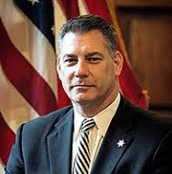Contact Us
To provide feedback on the Community Policing Dispatch, e-mail the editorial board at CPDispatch@usdoj.gov.
To obtain details on COPS Office programs, publications, and resources, contact the COPS Office Response Center at 800-421-6770 or AskCopsRC@usdoj.gov

U.S. Department of Justice
Office of Community Oriented Policing Services
Washington, DC 20530
Throughout the nation, law enforcement agencies are continuing to serve their communities in the face of the coronavirus and the numerous harms exposure can cause to first responders and community members alike. While social distancing measures and stay-at-home orders were implemented in many jurisdictions across country, law enforcement personnel remained in their jobs, playing a vital role in their communities.

New Podcasts

Fausto Pichardo
Chief of Patrol Services, New York Police Department
The NYPD’s Patrol Services Bureau is responsible for operations conducted by the majority of the department's uniformed officers. These officers work out of 77 precincts, each of which serves a population of between 70,000 and 150,000 people. Deputy Chief Pichardo speaks with the Beat about how the department responded to the coronavirus and shares his perspectives on the commitment of NYPD officers.

Peter Koutoujian
Sheriff, Middlesex County Sheriff’s Office (MA)
President, Major County Sheriffs of America
A career public servant, Sheriff Peter J. Koutoujian oversees one of the nation’s oldest law enforcement agencies: the Middlesex (Massachusetts) Sheriff’s Office. Sheriff Koutoujian joins the Beat to share his experiences and lessons learned leading his organization through the height of the coronavirus.
In New York City, the site of the earliest large outbreak of the coronavirus, 20 percent of New York City Police Department (NYPD) employees were out sick at the height of the pandemic. At the same time, the department was responding to changing crime trends resulting from the prevalence of the virus.
In New York, the overall crime rate dropped, but specific crimes increased. “During the pandemic, we’ve had an uptick in commercial burglary calls because so many businesses have been closed,” said Fausto Pichardo, NYPD’s Deputy Chief of Patrol.
Pichardo was recently interviewed by the Beat, the COPS Office’s podcast series, and he discussed the impact coronavirus had on NYPD operations. He also shared his thoughts about crime issues that he anticipates increasing as New York continues to open its economy.
“A lot of domestic violence survivors cannot come forward right now because if they come forward, they may really put themselves in harm's way while they are isolated with their abuser. So, we’ve been doing a lot of outreach... through our victim assistance programs we know some of our most vulnerable domestic violence survivors and we make sure we keep in contact with them,” said Pichardo.
Elsewhere, crime trends during the pandemic have varied. Research on national crime rates during the pandemic is still being conducted by many organizations, and the overall impact is yet to be determined. News reports from some cities reflect a decrease in all crime categories, while other cities—like New York—have experienced decreases overall but have had notable spikes in specific types of crime.
According to Trace, a news organization dedicated to the coverage of gun violence in the United States, gun violence in Baltimore, Chicago, Los Angeles, New Orleans, and Washington, D.C., decreased but remained elevated compared to other violent crimes under stay-at-home orders.
Correctional facilities represent another challenge for law enforcement during the pandemic. Options to implement social distancing and other protective measures are difficult for both inmates and staff.
During another recent interview with the Beat, Peter Koutoujian, President of Major County Sheriffs of America and the Sheriff of Middlesex County in Massachusetts shared lessons learned after leading his organization through the outbreak of the virus. “I remember the day that we got our first positive. I remember looking into the eyes of the entire staff at the Middlesex Sheriff’s Office and it was a very different institution once that happened. It was all academic until that point.”
In total, before the rate of the virus decreased in Massachusetts, 52 members of the sheriff’s office tested positive for COVID-19 and as many as 300 of their 600 staff members were out sick or quarantined at some point. As impactful as those lost workdays were to the organization, Koutoujian and the staff turned the losses into another opportunity to serve the community. “We started a program where staff can donate plasma to the Red Cross blood bank so that their blood that had once been positive for COVID-19 can now be used to treat those that are suffering.”
In every agency throughout the country, law enforcement officers continue to serve despite the risk the virus poses to them, and by extension, their family and co-workers. Through it all, they are learning what works best, adjusting to changing expectations and demands, and continuously displaying the level of courage and commitment that typifies American law enforcement.
Subscribe to Email Updates
To sign up for monthly updates or to access your subscriber preferences, please enter your email address in the Subscribe box.






